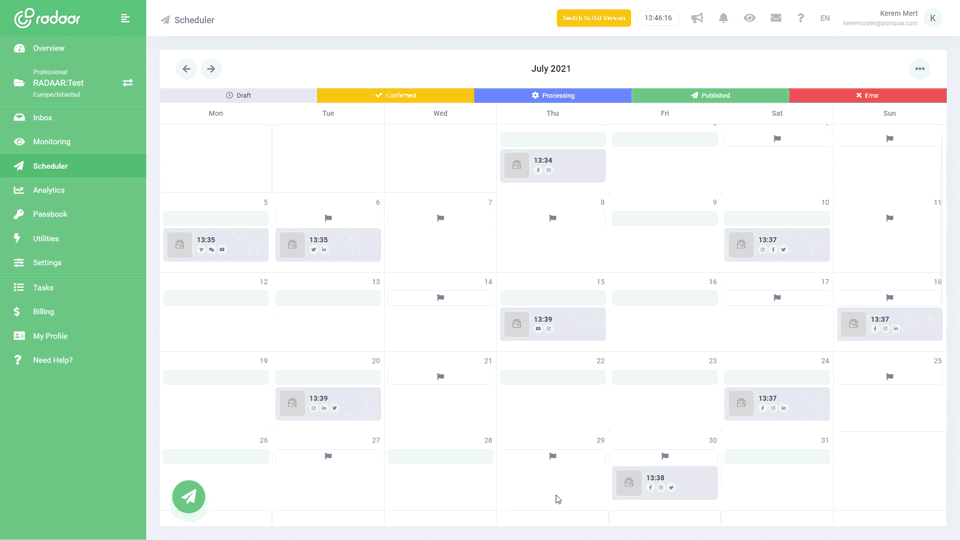Virtual influencers: are computer-generated personalities shaping our future online or just a passing marketing trend?
Explore how virtual influencers—AI-powered, computer-generated personalities—are redefining online marketing and social engagement. Discover if they're here to stay or just a digital fad.
LEARN MORE LAUNCH DEMO NOW The rise of virtual influencers—the AI-powered, computer-generated personalities—has shaken up the world of social media and digital marketing. These digital avatars act much like their human counterparts: they post selfies, share daily stories, and create engaging branded content for millions of followers. Brands are increasingly experimenting with these personalities, hoping to cut through the crowded social landscape with futuristic charm and unparalleled consistency. But with technology advancing so rapidly, it’s fair to ask if virtual influencers are a lasting force or simply the latest marketing novelty.
As the line between digital reality and fiction continues to blur, important questions emerge for both marketers and consumers. Are virtual influencers ushering in a new era of creativity and adaptability for brands, or do they amplify issues around authenticity, transparency, and trust? In this post, we’ll dive into what virtual influencers are, how brands are leveraging their unique strengths, the core risks brands should keep in mind, and highlight some of the most popular digital personalities captivating social media users today. Join us as we explore whether these AI-driven personas are genuinely shaping our digital future or just passing through.
As the line between digital reality and fiction continues to blur, important questions emerge for both marketers and consumers. Are virtual influencers ushering in a new era of creativity and adaptability for brands, or do they amplify issues around authenticity, transparency, and trust? In this post, we’ll dive into what virtual influencers are, how brands are leveraging their unique strengths, the core risks brands should keep in mind, and highlight some of the most popular digital personalities captivating social media users today. Join us as we explore whether these AI-driven personas are genuinely shaping our digital future or just passing through.
Table of Contents
- What exactly makes virtual influencers unique online today?
- How do virtual influencers actually operate behind scenes?
- What specific advantages do virtual influencers offer brands?
- Can virtual influencers foster genuine audience engagement and loyalty?
- What are the major risks for brands partnering virtually?
- How does transparency about AI shape influencer authenticity today?
- How do consumers perceive virtual influencers and their messaging?
- Who are the virtual influencers leading today’s social revolution?
- Will virtual influencers truly reshape marketing or fade away quietly?
What exactly makes virtual influencers unique online today?
Virtual influencers stand out in today's digital landscape because they are computer-generated characters designed to captivate online audiences. Unlike traditional human influencers, they can be endlessly customized and are not limited by real-world constraints. Their content strategy combines lifelike visuals, creative storytelling, and constant availability, making them appealing for brands seeking innovation. This unique blend of art, technology, and marketing gives virtual influencers a distinctive edge in the evolving world of influencer marketing.
How do virtual influencers actually operate behind scenes?
Virtual influencers are crafted by teams of digital artists, programmers and social media strategists who bring these AI-driven personalities to life. They rely on advanced technologies like CGI, motion capture and artificial intelligence to generate lifelike images, videos and even text-based interactions. Behind the scenes, each post and brand collaboration is carefully curated to align with marketing goals and audience engagement strategies. The seamless combination of artistry and technology ensures that virtual influencers operate convincingly, despite not existing in the physical world.
What specific advantages do virtual influencers offer brands?
Virtual influencers provide brands with unparalleled control and flexibility in their marketing campaigns. Because these digital personas are not human, brands can carefully curate every aspect of their appearance, messaging, and content. This ensures consistency in brand voice, reduces risks associated with unpredictable influencer behavior, and allows companies to tailor content to specific target audiences across multiple markets. Additionally, virtual influencers can be available 24/7, adapting their posts in real-time based on audience engagement and analytics.
Another key advantage of virtual influencers is their ability to transcend physical and cultural boundaries. They can 'travel' anywhere, speak any language, and quickly adopt the latest trends without the limitations of human needs or schedules. This opens up opportunities for global, cross-cultural campaigns that can reach diverse demographics efficiently. Furthermore, virtual influencers can help brands stand out in a crowded social media landscape by offering unique, attention-grabbing narratives that blend technology, creativity, and storytelling in ways traditional influencers cannot.
Another key advantage of virtual influencers is their ability to transcend physical and cultural boundaries. They can 'travel' anywhere, speak any language, and quickly adopt the latest trends without the limitations of human needs or schedules. This opens up opportunities for global, cross-cultural campaigns that can reach diverse demographics efficiently. Furthermore, virtual influencers can help brands stand out in a crowded social media landscape by offering unique, attention-grabbing narratives that blend technology, creativity, and storytelling in ways traditional influencers cannot.
Can virtual influencers foster genuine audience engagement and loyalty?
Virtual influencers present an intriguing opportunity for brands seeking to foster authentic engagement and build loyalty online. Thanks to advanced AI technologies, these digital personalities can interact with followers in real-time, responding to comments and customizing their content to audience preferences. However, questions about authenticity and emotional connection often linger, as audiences remain skeptical about forming bonds with computer-generated personas. Ultimately, the success of virtual influencers in cultivating genuine engagement depends on how creatively and transparently brands use them in their digital marketing strategies.
What are the major risks for brands partnering virtually?
Brands partnering with virtual influencers face several major risks, including potential brand safety and reputation issues if a virtual persona sparks controversy or backlash. There's also the challenge of maintaining transparency and authenticity, as audiences may struggle to trust endorsements from computer-generated characters. Legal concerns can arise from intellectual property misuse or unclear licensing of AI-generated assets, putting brands at risk of copyright infringement. Additionally, generic or copycat content may dilute a brand’s identity, ultimately undermining consumer trust and loyalty.
How does transparency about AI shape influencer authenticity today?
In today’s social media landscape, transparency about AI is essential for preserving influencer authenticity. When brands and creators clearly disclose the use of computer-generated personalities, it builds trust and credibility with audiences. Openness about AI-generated content helps consumers make informed decisions and minimizes the risk of deception. As virtual influencers become more advanced, honest communication is key for brands aiming to cultivate genuine online relationships.
How do consumers perceive virtual influencers and their messaging?
Consumers have mixed feelings toward virtual influencers and their messaging. While some audiences see them as innovative and exciting, others find their lack of authenticity and human experience concerning. Research shows that nearly half of people are uncomfortable with brands using AI influencers, highlighting the importance of transparency and trustworthy content. Brands must carefully consider how their virtual influencer campaigns are perceived to build genuine engagement and avoid skepticism.
Who are the virtual influencers leading today’s social revolution?
Virtual influencers like Lil Miquela, Imma, and Janky are redefining how brands engage with audiences on platforms like Instagram and TikTok. These leading digital personalities blend lifelike visuals with curated storytelling, seamlessly collaborating with top companies across fashion, tech, and lifestyle sectors. By consistently captivating millions of followers, they’ve become trendsetters shaping online culture and influencer marketing strategies. With their rising influence, virtual influencers are now at the forefront of the social media revolution.
Will virtual influencers truly reshape marketing or fade away quietly?
The future of virtual influencers in marketing is still being written, but their impact is already significant. With their ability to deliver highly controlled, adaptable, and consistent brand messaging, these computer-generated personalities offer unique opportunities for brands wanting to stand out in a crowded digital space. However, concerns about authenticity, transparency, and genuine connection remain front of mind for both brands and consumers. Whether virtual influencers can overcome skepticism and truly earn consumer trust will greatly influence their longevity and evolution in online marketing.
For marketers considering virtual influencer partnerships, success will hinge on a thoughtful, audience-centric approach that emphasizes transparency and adds real value—not just novelty. While some see virtual influencers as a fleeting trend, others view them as the next frontier in digital storytelling. As social media platforms and audience preferences continue to evolve, only time will tell whether virtual influencers become a mainstay or quietly fade into the background. Ultimately, brands who carefully weigh the risks and benefits and stay attuned to audience sentiment will be best positioned to harness the true potential of this innovative marketing tool.
For marketers considering virtual influencer partnerships, success will hinge on a thoughtful, audience-centric approach that emphasizes transparency and adds real value—not just novelty. While some see virtual influencers as a fleeting trend, others view them as the next frontier in digital storytelling. As social media platforms and audience preferences continue to evolve, only time will tell whether virtual influencers become a mainstay or quietly fade into the background. Ultimately, brands who carefully weigh the risks and benefits and stay attuned to audience sentiment will be best positioned to harness the true potential of this innovative marketing tool.
SOCIAL MEDIA SCHEDULER
Plan and publish...
Plan and publish your content for Facebook, Instagram, Twitter, and LinkedIn from one simple dashboard.
LEARN MORE FREQUENTLY ASKED QUESTIONS
Are virtual influencers here to stay?
Curious about virtual influencers and their impact? Find all the answers to your frequently asked questions in this section.
RELATED BLOG POSTS
All the tips & tricks you'll need...
Get the fresh tips and tricks you'll need to ace social media marketing.













